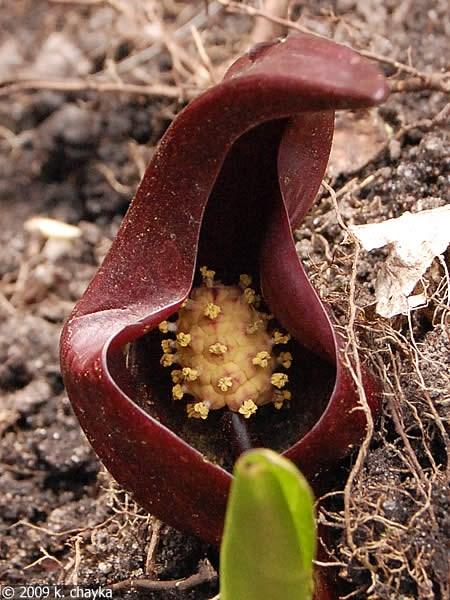
2 minute read
Skunk Cabbage
The Mysterious Skunk Cabbage
by Ryan Koch
Brought to you by the maker of all living things and the producer of kingdom Plantae, Mother Nature has brought to the world a unique species of plant that probably smells worse than it looks. Transforming from a small bud into a spiraling leafed plant, skunk cabbage usually emerges between February and May. It’s one of the first to flower due to a process called thermogenesis. During the process, great amounts of oxygen and starch are consumed, producing intense heat as it grows. If you ever take a walk through the woods in the late winter when there is snow on the ground, keep an open eye for melted patches of snow with small skunk cabbage buds. The buds are typically found on the edges of streams and creeks. Thermogenesis has the ability to produce heat 36° above the air temperature, hence the reason it can melt snow. If a skunk cabbage plant was around on a bitter 0° day in the snow, it would still be able to produce enough heat to melt the freezing snow and continue to grow. When the plant is first emerging from the ground, the bud, called the spathe, has a flame-like shape and grows vertically. As the spathe grows larger, its leaves start to unravel and the spadix (the bud) becomes visible. If you were to touch the spadix, it would feel very warm; thus, this is where the heat is generated from. When the bud is large enough, the cabbage-like leaves emerge spirally into broad leaves that can reach two feet in length. Another interesting part of its lifecycle is when the leaves begin to decompose. Normally, leaves dry up and fall to the ground to later decompose. Skunk cabbage is different. Small holes begin to form in the leaves and they then turn black. This keeps happening until all the leaves are gone, having decomposed in midair.
You might think its early emergence would make it more vulnerable to being eaten by hungry animals; however, evolution has helped it survive against negative things like this. When most animals eat the cabbage-like leaves of the plant, a strong inflammatory reaction occurs in the animals’ mouths. This is an ecological defense mechanism used to deter animals from eating the whole plant. Skunk cabbage does not always discourage every animal from approaching it. Some animals, like bears, love eating the buds and leaves off the plant right after coming out of hibernation. Bites from the beaks of wild turkeys have also been observed in the leaves of skunk cabbage. One of the primary reasons skunk cabbage produces such a foul odor is to attract insects to pollinate the plant. Some of these pollinators include bees, flies, beetles, and butterflies.
Skunk cabbage was used by Native Americans for medicinal purposes, and it has been said that the roots have special healing properties. Some of these conditions include asthma, coughing, headaches, epilepsy, anxiety, swelling, and infections. However, more evidence on medicinal uses of skunk cabbage is needed to better understand it. The stems and leaves can also be eaten if cooked properly. The next time you are out in the woods and see budding skunk cabbage plants, you will know a few things: it will burn your mouth if you eat it, and spring is around the corner.
Sources
http://www.scarthphoto.com/skunkcabbage.htm http://www.nwf.org/wildlife/wildlife-library/plants/ skunk-cabbage.aspx http://www.fcps.edu/islandcreekes/ecology/ skunk_cabbage.htm http://www.minnesotawildflowers.info/flower/skunkcabbage http://natureinstitute.org/pub/ic/ic4/skunkcabbage.htm










